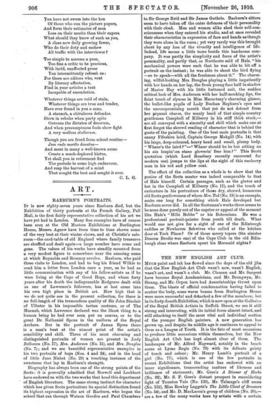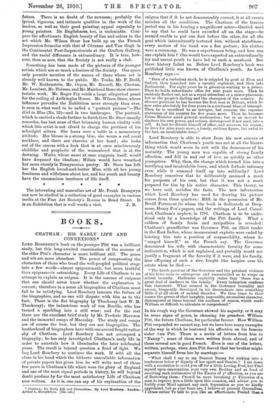THE NEW ENGLISH ART CLUB.
Mona paint and ink has flowed since the days of the old jibe that the New English Art Club wasn't new, wasn't English, wasn't art, and wasn't a club. Mr. Clausen and Mr. Sargent have become Royal Academicians, and Mr. Brangwyn, Mr. Strang, and Mr. Orpen have had Associateships thrust upon them. The blasts of official condemnation having failed to scatter the body, some warm beams from Burlington House were more successful and detached a few of the members; but in its forty-fourth Exhibition; which is now open at the Galleries of the Royal British Artists in Suffolk Street, we see it still strong and interesting, with its initial force almost intact, and still attaching to itself the most vital and individual section of the younger English painters. A new generation has grown up, and despite its middle age it continues to appeal to them as a League of Youth. It is the fate of most secessions to produce little secessions within themselves, but the New English Art Club has kept almost clear of them. The landscapes of Mr. Alfred Hayward, notably in the beach scene at Lyme Regis (No. 78) with its delicate gaiety of touch and colour ; Mr. Henry Lamb's portrait of a girl (No. 77), which is one of the few portraits in recent Exhibitions that the artist has endowed with an inner significance, transcending matters of likeness and brilliance of statement ; Mr. Gere's A Dinner of Herbs (No. 92), Mr. S. F. Gore's distant prospect in smouldering light of Taunton Vale (No. 139), Mr. Talmage's cliff scene (No. 132), Miss Rowley Leggett's The Little Chest of Drawers (No. 54), and Mr. D. MacLaren's group of children (No. 20),— are a few of the many works here by artists with a certain future. There is no doubt of the newness; probably the lyrical, vigorous, and intimate qualities in the work of the leaders, as well as their good painting, appeal especially to young painters. Its Englishness, too, is undeniable. Com- pare the affectionate English beauty of line and colour in the art which Mr. Wilson Steer has built up on the French Impression formulas with that of Cezanne and Van Gogh in the Continental Post-Impressionists at the Grafton Gallery, and the racial difference is extraordinary. It is true, how- ever, then as now, that the Society is not really a club.
Something has been made of the pictures of the younger artiste which are so much a feature of the Society. Our space only permits mention of the names of those whose art is already well known to the public. Mr. Tonks, Mr. F. Dodd, Mr. W. Rothenstein, Mr. Orpen, Mr. Russell, Mr. Chowne, Mr. Lambert, Mr. Holmes, and Mr. Muirhead Bone show charac- teristic work. Mr. Roger Fry sends a large allegorical panel for the ceiling of Ardkinglas House. Mr. Wilson Steer, whose influence pervades the Exhibition more strongly than ever, is seen in what used to be called a "portrait picture "—The Girl in Blue (No. 32)—and in two landscapes. The portrait, which is carried a shade further in finish than Mr. Steer usually concedes, has lost none of that brimming human vitality with which this artist is not afraid to charge the prettiest of his schoolgirl sitters. She leans over a table in a momentary attitude. Her blouse is a strong blue, she wears a red coral necklace, and there are cherries at her hand ; she looks out of the canvas with a look that is at once mischievously childlike and prophetic of the womanhood that is at the dawning. Watts, whose name at once suggests itself, would have deepened the idealism; Millais would have wreathed her more closely hi Tennysonian poetry. Mr. Steer has left her the English bread-and-butter Miss, with all her young freshness and wilfulness about her, and her youth and beauty have the unconscious insolence of life itself.
The interesting and masculine art of Mr. Frank Brangwyn can now be studied in a collection of good examples in various media at the Fine Art Society's Rooms in Bond Street. It is an Exhibition that is well worth a visit. J. B.



















































 Previous page
Previous page